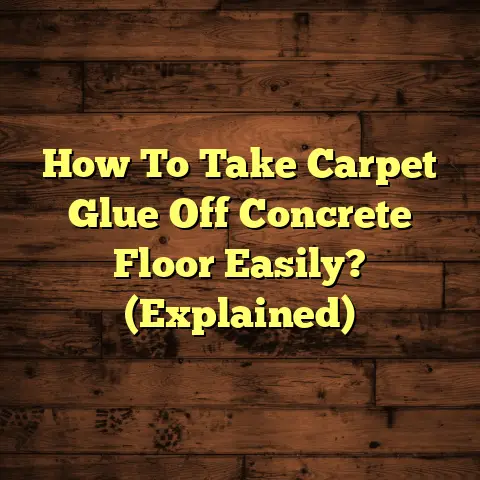Laminate Over Floorboards? (5 Install FAILS!)
But here’s a little secret from a flooring contractor who’s seen it all: slapping laminate over existing floorboards can be a real minefield if you’re not careful.
I’ve seen countless DIY projects (and even some “professional” jobs) go south, and I’m here to help you avoid the same fate.
We’re diving deep into the five most common install FAILS when it comes to laminate over floorboards. Trust me, knowing these can save you serious time, money, and a whole lot of frustration. Ready? Let’s get started!
Understanding the Basics
of Laminate Flooring
Before we jump into the mistakes, let’s get crystal clear on what laminate flooring actually is.
Definition and Composition
Think of laminate as a layered cake. You’ve got:
-
The Backing Layer: This is the foundation. It’s designed to provide stability and protect against moisture from below.
-
The Core Layer: Usually made of high-density fiberboard (HDF) or medium-density fiberboard (MDF), this is the heart of the laminate. It gives the flooring its strength and impact resistance.
-
The Decorative Layer: This is where the magic happens! A high-resolution image of wood, stone, or tile is printed on this layer, giving the laminate its realistic look.
-
The Wear Layer: This is the protective shield. It’s a transparent coating that guards against scratches, stains, and fading.
The way these layers work together is crucial. When you install laminate over floorboards, you’re essentially adding another layer to the equation, which can affect how the whole system performs.
Benefits of Laminate
Okay, so why is laminate so popular? Here’s the lowdown:
-
Durability: Laminate is tough! That wear layer can withstand a lot of abuse, making it great for high-traffic areas.
-
Variety: You want wood? Stone? Tile? Laminate comes in a gazillion styles and colors. You’re bound to find something that fits your taste.
-
Easy Maintenance: Sweep, vacuum, and occasionally mop – that’s all it takes to keep laminate looking good.
-
Affordability: Compared to hardwood or tile, laminate is a budget-friendly option.
Why Install Over Floorboards?
Now, the million-dollar question: why not just rip out the old floorboards? Well, there are a few reasons:
-
Cost: Removing floorboards can be expensive, especially if you have a large area to cover.
-
Time: Demo work is time-consuming and messy. Installing over the existing floorboards can save you a lot of hassle.
-
Original Wood: Some homeowners love the character of their original floorboards and want to preserve them.
-
Leveling: In some cases, the existing floorboards provide a relatively level surface that’s easier to work with than a bare subfloor.
But here’s the catch: installing laminate over floorboards isn’t always a slam dunk. You need to do it right. Which brings us to…
Install FAIL #1 – Inadequate
Subfloor Preparation
This is the big one. I can’t stress enough how critical it is to prep the subfloor properly.
Description of the Issue
Think of your subfloor (in this case, your existing floorboards) as the foundation of your entire flooring system. If it’s not solid, level, and clean, you’re setting yourself up for trouble.
Common problems include:
-
Uneven Surfaces: Gaps, warps, or dips in the floorboards can create an uneven surface for the laminate.
-
Loose Boards: Floorboards that are loose or squeaky will transfer that movement to the laminate.
-
Debris: Dirt, dust, nails, and staples can interfere with the laminate installation and cause damage over time.
Consequences
So, what happens if you skip the prep work?
-
Uneven Flooring: You’ll feel it underfoot. Walking on an uneven floor is annoying and can even be a tripping hazard.
-
Squeaks: Those squeaky floorboards will still squeak, only now they’ll be amplified by the laminate.
-
Damage to Laminate: Uneven surfaces can cause the laminate planks to flex and eventually break or separate.
-
Moisture Problems: Gaps in the subfloor can allow moisture to seep in, leading to mold, mildew, and rot.
Real-Life Example
I once had a client who was determined to save money by skipping the subfloor prep. He installed laminate over old, uneven floorboards that were riddled with gaps. Within a few months, the laminate started buckling and separating.
He called me back in a panic, and I had to break the bad news: the entire floor needed to be ripped up and the subfloor properly prepared. In the end, he spent more money than he would have if he’d done it right the first time.
How to avoid this:
-
Inspect Thoroughly: Walk around the room and look for any signs of unevenness, loose boards, or damage.
-
Level the Subfloor: Use a self-leveling compound to fill in any dips or low spots.
-
Secure Loose Boards: Screw down any loose floorboards to prevent squeaks and movement.
-
Clean Thoroughly: Vacuum, sweep, and scrape away any debris.
Install FAIL #2 – Ignoring
Moisture Concerns
Moisture is the enemy of laminate flooring. And when you’re installing over floorboards, you need to be extra vigilant.
Description of the Issue
Old floorboards can hold a surprising amount of moisture, especially if they’re in a damp basement or near a leaky pipe. This moisture can then seep into the laminate, causing all sorts of problems.
Consequences
Here’s what can happen when moisture gets into your laminate:
-
Warping: The laminate planks can warp and become distorted.
-
Buckling: The floor can buckle and lift up in certain areas.
-
Mold and Mildew: Moisture creates the perfect breeding ground for mold and mildew, which can be a health hazard.
-
Adhesive Failure: If you’re using adhesive to install the laminate, moisture can weaken the bond and cause the flooring to come loose.
Real-Life Example
I remember a homeowner who installed laminate in her basement without checking the moisture levels. She thought the floorboards were dry, but she was wrong. Within a few weeks, the laminate started to buckle and the room smelled musty.
It turned out that the floorboards had absorbed moisture from the ground. She had to tear out the entire floor, install a moisture barrier, and start from scratch.
How to avoid this:
-
Test Moisture Levels: Use a moisture meter to check the moisture content of the floorboards. Ideally, it should be below 12%.
-
Install a Moisture Barrier: This is a plastic sheet that you lay down over the floorboards to prevent moisture from rising up into the laminate.
-
Ensure Proper Ventilation: Make sure the room is well-ventilated to prevent moisture buildup.
Install FAIL #3 – Choosing the
Wrong Laminate Thickness
Thickness matters! You can’t just grab any old laminate off the shelf and expect it to perform well over floorboards.
Description of the Issue
Laminate flooring comes in a variety of thicknesses, typically ranging from 6mm to 12mm. The right thickness depends on the condition of your subfloor and the amount of traffic the floor will receive.
-
Too Thin: If the laminate is too thin, it may not be able to bridge any minor imperfections in the subfloor. It can also feel flimsy and uncomfortable underfoot.
-
Too Thick: If the laminate is too thick, it can create a height difference with adjacent flooring, leading to tripping hazards. It can also be more difficult to install.
Consequences
Here’s what can happen if you choose the wrong thickness:
-
Cracking and Chipping: Thin laminate is more prone to cracking and chipping, especially in high-traffic areas.
-
Bouncy Feel: If the laminate is too thin and the subfloor is uneven, the floor can feel bouncy or spongy.
-
Difficulty Installing: Thick laminate can be harder to cut and install, especially if you’re working in a tight space.
-
Transition Issues: A significant height difference between the laminate and adjacent flooring can create an awkward transition.
Real-Life Example
I once had a client who insisted on using a very thin laminate to save money. The floorboards were slightly uneven, and the thin laminate just couldn’t handle it. Within a few months, the floor started to crack and chip. She ended up having to replace the entire floor with a thicker, more durable laminate.
How to avoid this:
-
Assess the Subfloor: If the floorboards are relatively even and in good condition, you can get away with a thinner laminate (8mm or less). If they’re uneven or damaged, you’ll need a thicker laminate (10mm or more).
-
Consider Traffic: High-traffic areas like hallways and living rooms require a thicker laminate than low-traffic areas like bedrooms.
-
Check Transition Heights: Measure the height of the laminate and underlayment to ensure a smooth transition to adjacent flooring.
Install FAIL #4 – Not Allowing
for Expansion Gaps
Laminate flooring needs room to breathe. Ignoring expansion gaps is a recipe for disaster.
Description of the Issue
Laminate flooring expands and contracts with changes in temperature and humidity. If you don’t leave enough space around the perimeter of the room, the laminate will have nowhere to go when it expands.
Consequences
Here’s what can happen if you don’t leave expansion gaps:
-
Buckling: The laminate can buckle and lift up in the middle of the room.
-
Warping: The planks can warp and become distorted.
-
Squeaking: The floor can start to squeak as the laminate rubs against the walls.
-
Damage to Walls: In extreme cases, the expanding laminate can even push against the walls and cause damage.
Real-Life Example
I had a customer who installed laminate in his living room without leaving any expansion gaps. He thought it would look cleaner and more professional. But within a few weeks, the floor started to buckle and the walls started to crack. He had to tear out the entire floor and reinstall it with proper expansion gaps.
How to avoid this:
-
Leave a Gap: Use spacers to maintain a gap of at least 1/4 inch (6mm) around the perimeter of the room.
-
Don’t Block the Gap: Make sure the gap is free of debris and that furniture or baseboards aren’t blocking it.
-
Use Transition Strips: Cover the expansion gaps with transition strips or baseboards to give the floor a finished look.
Install FAIL #5 – Poor Quality
Underlayment Choices
Underlayment is the unsung hero of laminate flooring. Don’t skimp on it!
Description of the Issue
Underlayment is a thin layer of material that you install between the subfloor and the laminate. It provides cushioning, reduces noise, and helps to protect the laminate from moisture.
-
Too Thin: If the underlayment is too thin, it won’t provide enough cushioning or noise reduction.
-
Wrong Material: Some underlayments are not compatible with laminate flooring.
-
No Moisture Barrier: Some underlayments don’t have a built-in moisture barrier, which can lead to moisture problems.
Consequences
Here’s what can happen if you choose the wrong underlayment:
-
Noise Issues: The floor will be noisy and echoey.
-
Reduced Cushioning: The floor will feel hard and uncomfortable underfoot.
-
Increased Wear: The laminate will wear out faster.
-
Moisture Problems: Moisture can seep into the laminate and cause damage.
Real-Life Example
I worked with a homeowner who tried to save money by using a cheap, thin underlayment. The floor was incredibly noisy, and you could hear every footstep. She ended up having to replace the underlayment with a thicker, more sound-absorbing material.
How to avoid this:
-
Choose the Right Thickness: For laminate flooring, look for an underlayment that is at least 2mm thick.
-
Consider Sound Absorption: If you live in an apartment or have kids, choose an underlayment that is specifically designed to reduce noise.
-
Look for a Moisture Barrier: Choose an underlayment that has a built-in moisture barrier to protect the laminate from moisture.
-
Read Reviews: Check online reviews to see what other homeowners have to say about different underlayment products.
Reflecting on Install FAILS
So, there you have it – the five most common install FAILS when it comes to installing laminate over floorboards.
Remember, while it can be a great way to update your home on a budget, it’s crucial to do it right. Don’t cut corners on subfloor preparation, moisture control, laminate thickness, expansion gaps, or underlayment.
By avoiding these common mistakes, you can ensure a beautiful, durable, and long-lasting laminate floor that you’ll enjoy for years to come.
Happy flooring!





